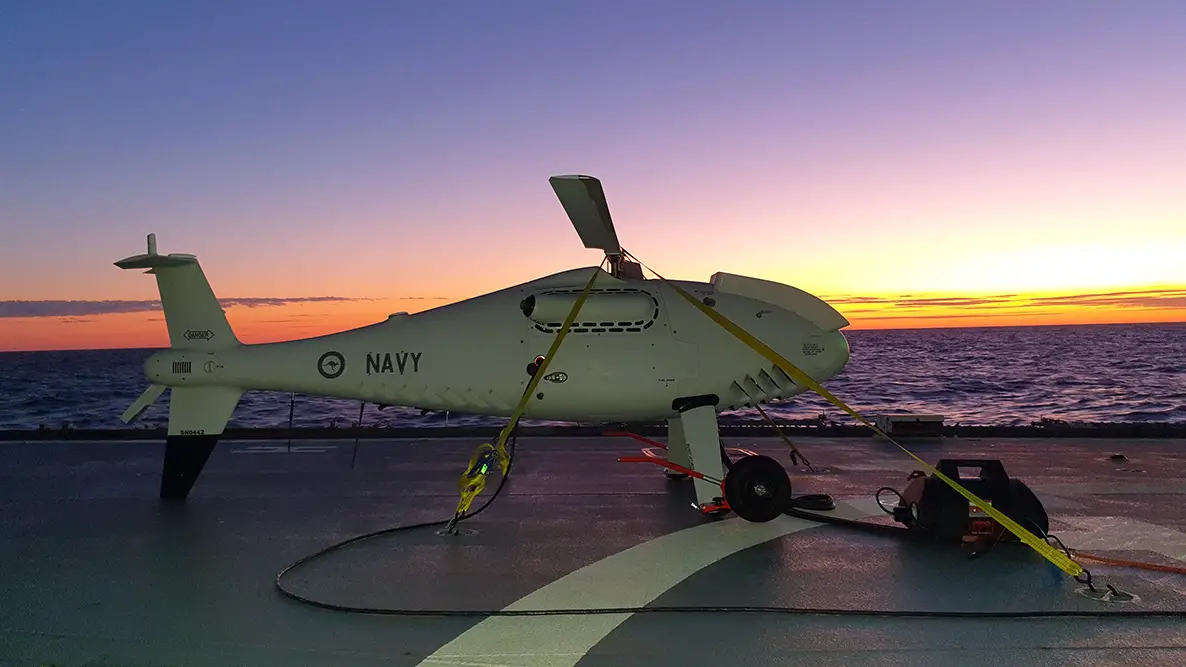Two of Royal Australian Navy (RAN) newest cutting-edge capabilities have combined, with the Anzac Class Frigate HMAS Ballarat (FFH 155) embarking an S-100 Camcopter Unmanned Aerial Vehicle for flight trials off the Eastern coast of Australia. Personnel from Royal Australian Navy’s 822X Squadron and test specialists from the Aircraft Maintenance and Flight Trials Unit (AMAFTU) embarked HMAS Ballarat to collect data on how the 200 kilogram S-100 Camcopter Unmanned Aerial Vehicle (UAV) can launch and be retrieved at sea.
The trials were an important part of learning how to combine the payload capacity of the S-100 Camcopter with the warfare capabilities of the 118-metre long Anzac Class Frigate. The deployment of unmanned systems at sea will become a more common theme in modern maritime warfare, especially with the advent and continued development of artificial intelligence and robotic or autonomous systems. Maximising their ability to safely operate in a variety of environmental conditions is fundamental to their operational utility and making them a force multiplier.

The S-100 Camcopter could support surface, amphibious or anti-submarine warfare, as well as in search and rescue and humanitarian assistance and disaster relief. The introduction of unmanned aviation operations at sea is a paradigm shift for Navy and it will enable us to detect threats at greater ranges and better defend RAN ships and give us enhanced situational awareness. S-100 Camcopter is capable of vertical take-off and landing while carrying multiple payloads simultaneously. It can fly for up to several hours at a time and reach a maximum speed in excess of 100km/h.
822X Squadron’s mission is to conduct experimentation and evaluation activities with contemporary Unmanned Aircraft Systems (UAS) and advanced payloads to develop operational knowledge and experience, develop orders and procedures supporting safe UAS operations, and to assess UAS capability options that support integrated warfare outcomes for the future Fleet. The Navy UAS Development Unit (NUASDU) was formed in late 2012 with the primary purpose of conducting experimentation activities with an exemplar UAS in order to develop an in-depth understanding of the potential capabilities of MTUAS.

The Schiebel Camcopter S-100 is an Austrian unmanned aerial vehicle (UAV) using a rotorcraft design.The Schiebel Camcopter S-100 UAS was acquired by Navy in late 2016 to broaden the Navy’s understanding of Vertical Take off and Landing (VTOL) UAS. The S-100 was accepted into Navy service on 30 April 2018. NUASU expanded to 32 personnel, enabling the deployment of one ScanEagle flight and one S-100 Flight to sea for embarked evaluation activities while maintaining one ScanEagle Flight at Nowra for training and land-based experimentation activities. Produced by the Austrian company Schiebel, it was developed from 2003 to 2005.
Ballarat is one of eight Anzac Class Frigates in Navy’s fleet and is capable of long-range air defence, surface and undersea warfare, surveillance, reconnaissance and interdiction. HMAS Ballarat (FFH 155) is an Anzac-class frigate of the Royal Australian Navy (RAN). The frigate was laid down in 2000 and commissioned into the RAN in mid-2004. Since entering service, Ballarat has been involved in border protection as part of Operation Relex II, was deployed to the Gulf for Operation Catalyst, and was one of the two ships involved in the Operation Northern Trident 2009 round-the-world voyage. Ballarat has undergone the Anti-Ship Missile Defence (ASMD) upgrade, completing in 2015.












